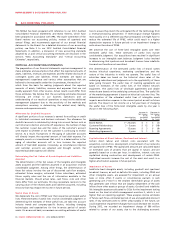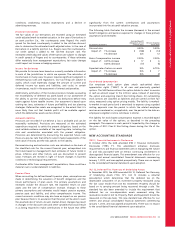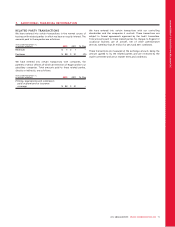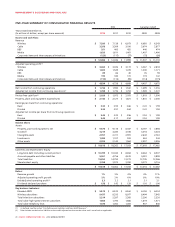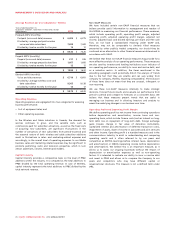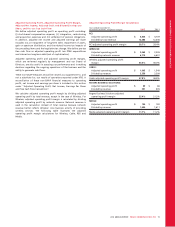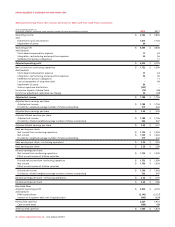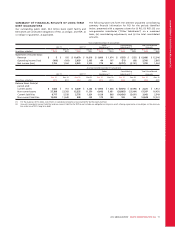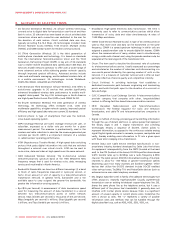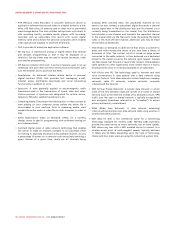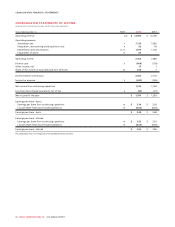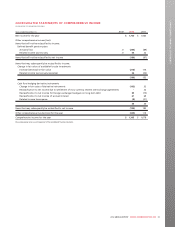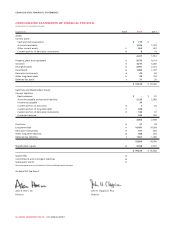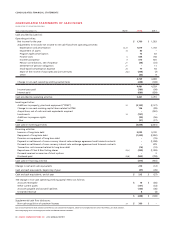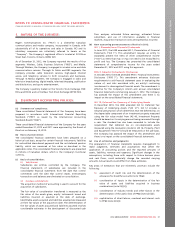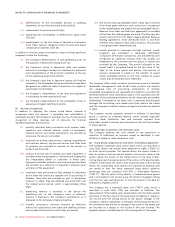Rogers 2012 Annual Report Download - page 82
Download and view the complete annual report
Please find page 82 of the 2012 Rogers annual report below. You can navigate through the pages in the report by either clicking on the pages listed below, or by using the keyword search tool below to find specific information within the annual report.
MANAGEMENT’S DISCUSSION AND ANALYSIS
8. GLOSSARY OF SELECTED TERMS
• 2G (Second Generation Wireless): 2G cellular wireless technology
converts voice to digital data for transmission over the air and then
back to voice. 2G data services were based on circuit switched data
connections where each connection was dedicated to the user for
the duration of each session. Circuit switched data was slow,
typically providing 9.6-14.4 Kbps. 2G technologies included Code
Division Multiple Access (CDMA), Time Division Multiple Access
(TDMA), and GSM (Global System for Mobile communications).
• 3G (Third Generation Wireless): 3G is the third generation of
mobile phone standards and technology. It is based on standards
from the International Telecommunication Union and the Third
Generation Partnership Project (3GPP). A key aim of 3G standards
was to enable mobile broadband data speeds above 384 Kbps. 3G
networks enable network operators to offer users a wider range of
more advanced services while achieving greater network capacity
through improved spectral efficiency. Advanced services include
video and multimedia messaging, and broadband wireless data, all
in a mobile environment. 3G technologies include Wideband-
CDMA (W-CDMA), cdma2000 and TD/SCDMA.
• 3.5G (Enhanced Third Generation Cellular Wireless): 3.5G refers to
evolutionary upgrades to 3G services that provide significantly
enhanced broadband wireless data performance to enable multi-
megabit data speeds. The key 3.5G technologies in North America
are High-Speed Packet Access Plus (HSPA+) and CDMA EV-DO.
• 4G (Fourth Generation Wireless): The latest generation of wireless
technology. 4G technology offers increased voice, video and
multimedia capabilities, a higher network capacity, improved spectral
efficiency and high-speed data rates over current 3G standards.
• Android phone: A type of smartphone that uses the Android,
Linux-based operating system.
• ARPU (Average Revenue per User): Average revenue per user, or
subscriber, expressed as a dollar rate per month for a given
measurement period. The measure is predominantly used in the
wireless and cable industries to describe the revenue generated per
customer per month. ARPU is an important indicator of a wireless
or cable business’ operating performance.
• ATM (Asynchronous Transfer Mode): A high-speed data switching
protocol that packs digital information into cells that are switched
throughout a network over virtual circuits. ATM can be used to
route voice, data and video at high speeds over the same network.
• AWS (Advanced Wireless Services): The bi-directional wireless
telecommunications spectrum band at the 1900 MHz/2100 MHz
frequency ranges that is used for wireless voice, data, messaging
services and multimedia in North America.
• Bandwidth: Bandwidth can have two different meanings: (i) a band
or block of radio frequencies measured in cycles per second, or
hertz; (ii) an amount or unit of capacity in a telecommunications
transmission network. In general terms, bandwidth and is the
available space to carry a signal: the greater the bandwidth, the
greater the information-carrying capacity.
• Bps (Bits per Second): A measurement of data transmission speed
used for measuring the amount of data transferred in a second
between two telecommunications points or within network
devices. Kbps (kilobits per second) is thousands of bits per second;
Mbps (megabits per second) is millions; Gbps (gigabits per second)
is billions; and Tbps (terabits per second) is trillions.
• Broadband: High-speed electronic data transmission. The term is
commonly used to refer to communications services which allow
transmission of voice, data and video simultaneously at rates of
1.544 Mbps and above.
• CDMA (Code Division Multiple Access): A type of 2G wireless protocol
used so that more voice and data can be transmitted on the same
frequency. CDMA is a spread spectrum technology in which calls are
assigned a pseudo-random code to encode digital bit streams. CDMA
allows the communications of many wireless users to simultaneously
occupy a wide radio channel and, using the pseudo-random code, be
separated at the receiving end of the transmission link.
• Churn: The term used to describe the disconnect rate of customers
to a telecommunications service. Usually expressed as a percentage
and calculated as the number of subscriber units disconnecting in a
one month period divided by the opening number of units on the
network. It is a measure of customer turnover and is often at least
partially reflective of service quality and competitive intensity.
• Circuit Switched: A switching technique that establishes a
dedicated transmission path between originating and terminating
points and holds that path open for the duration of a voice call or
data exchange.
• CLEC (Competitive Local Exchange Carrier): A telecommunications
provider company that competes with other, long-established
carriers in offering facilities-based telecommunications services.
• CRTC (Canadian Radio-television and Telecommunications
Commission): The federal regulator for radio and television
broadcasters, and cable-TV and telecommunications companies in
Canada.
• Digital: A method of storing, processing and transmitting information
through the use of distant electronic or optical pulses that represent
the binary digits 0 and 1. Digital transmission and switching
technologies employ a sequence of discrete, distinct pulses to
represent information, as opposed to the continuous variable analog
signal. Digital signals are easier to recreate, compress, manipulate and
verify, thereby enabling more information to fit into a given space
with fewer errors creeping into a transmission.
• DOCSIS (Data over Cable Service Interface Specification): A non-
proprietary industry standard developed by Cable Labs that allows
for equipment interoperability from the CMTS (located at the head
end) to the CPE (located at the home). DOCSIS specifies downstream
traffic transfer rates up to 36 Mbps over a radio frequency 6 MHz
channel. The latest version (DOCSIS 3.0) enables bonding of multiple
channels to allow for +100 Mbps or greater transmission speeds
depending upon how many channels are bonded together. Other
devices that utilize the DOCSIS standard include DOCSIS enabled
video set-top boxes, Tru2Way TV’s and PacketCable devices (such as
enhanced voice over cable telephony modems).
• DSL (Digital Subscriber Line): A family of broadband technologies that
offers always-on, relatively high-bandwidth (usually asymmetrical)
transmission over an existing twisted-pair copper telephone line. DSL
shares the same phone line as the telephone service, but it uses a
different part of the phone line’s bandwidth. It generally does not
interfere with normal phone service because there is a significant
amount of unused capacity in current phone wires. Sometimes the
term is shown as xDSL. The “x” represents a variety of possible
information rates and methods that can be handled through the
digital subscriber loop, such as ADSL, HDSL, SDSL, VDSL, etc.
78 ROGERS COMMUNICATIONS INC. 2012 ANNUAL REPORT


